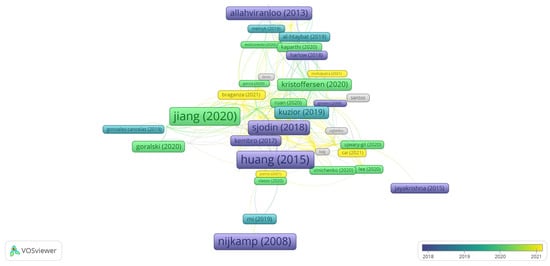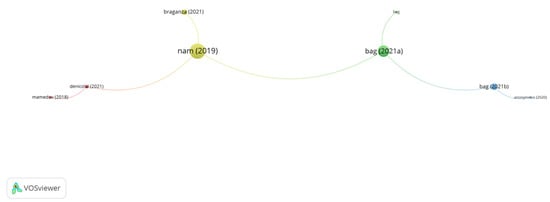This study’s objective is to provide an overview on literature state-of-the-art related to sustainable tourism and technological innovations, offering insights for further advancing this domain. We employ a bibliometric analysis and a comprehensive review of 139 articles, collected from Web of Science and Scopus databases, for the purpose of: (i) exploring and discussing the most relevant contributions in the publication network: (ii) highlighting key issues and emerging topics; (iii) uncovering open questions for the future. Our findings reveal contradictory views on the risks and benefits of technology adoption. Artificial intelligence, internet of things, circular economy, big data, augmented and virtual reality emerge as major trends. Five work streams are identified and described, leading to a broader perspective on how technology can shape the future of sustainable tourism. Relevant theoretical and managerial implications are derived. Finally, a research agenda is proposed as guidance for future studies addressing the outcomes of digital disruption on sustainable tourism.
- bibliometric analysis
- eco-tourism
- sustainability
- tourism
- artificial intelligence
- virtual reality
- augmented reality
- research agenda
- future trends
1. Introduction
2. Cooperative Network of Authors, Countries of Affiliation and Documents



3. Citation and Co-Citation Analysis


4. Co-Occurrences of Keywords

This entry is adapted from the peer-reviewed paper 10.3390/su132212691
References
- Untaru, E.N.; Ispas, A.; Candrea, A.N.; Luca, M.; Epuran, G. Predictors of Individuals’ Intention to Conserve Water in a Lodging Context: The Application of an Extended Theory of Reasoned Action. Int. J. Hosp. Manag. 2016, 59, 50–59.
- Choi, H.; Jang, J.; Kandampully, J. Application of the Extended VBN Theory to Understand Consumers’ Decisions about Green Hotels. Int. J. Hosp. Manag. 2015, 51, 87–95.
- Sung, Y.A.; Kim, K.W.; Kwon, H.J. Big Data Analysis of Korean Travelers’ Behavior in the Post-COVID-19 Era. Sustainability 2021, 13, 310.
- Miceli, A.; Hagen, B.; Riccardi, M.P.; Sotti, F.; Settembre-Blundo, D. Thriving, Not Just Surviving in Changing Times: How Sustainability, Agility and Digitalization Intertwine with Organizational Resilience. Sustainability 2021, 13, 2052.
- Filimonau, V.; Matute, J.; Mika, M.; Faracik, R. National Culture as a Driver of Pro-Environmental Attitudes and Behavioural Intentions in Tourism. J. Sustain. Tour. 2018, 26, 1804–1825.
- Kim, K.H.; Park, D.B. Relationships among Perceived Value, Satisfaction, and Loyalty: Community-Based Ecotourism in Korea. J. Travel Tour. Mark. 2017, 34, 171–191.
- Loureiro, S.M.C.; Guerreiro, J.; Han, H. Past, Present, and Future of pro-Environmental Behavior in Tourism and Hospitality: A Text-Mining Approach. J. Sustain. Tour. 2021, 1–21, ahead-of-print.
- United Nations World Tourism Organization Sustainable Tourism Development. Available online: https://www.unwto.org/sustainable-development (accessed on 19 October 2021).
- Spencer, J. The sustainable development goals. Available online: https://unstats.un.org/sdgs/report/2020/The-Sustainable-Development-Goals-Report-2020.pdf (accessed on 4 May 2021).
- De Carlo, M.; Ferilli, G.; d’Angella, F.; Buscema, M. Artificial Intelligence to Design Collaborative Strategy: An Application to Urban Destinations. J. Bus. Res. 2021, 129, 936–948.
- Lalicic, L.; Weismayer, C. Consumers’ Reasons and Perceived Value Co-Creation of Using Artificial Intelligence-Enabled Travel Service Agents. J. Bus. Res. 2021, 129, 891–901.
- Golja, T.; Paulišić, M. Managing-Technology Enhanced Tourist Experience: The Case of Scattered Hotels in Istria. Management 2021, 26, 63–95.
- de Kervenoael, R.; Hasan, R.; Schwob, A.; Goh, E. Leveraging Human-Robot Interaction in Hospitality Services: Incorporating the Role of Perceived Value, Empathy, and Information Sharing into Visitors’ Intentions to Use Social Robots. Tour. Manag. 2020, 78, 104042.
- Loureiro, S.M.C.; Japutra, A.; Molinillo, S.; Bilro, R. Stand by Me: Analyzing the Tourist–Intelligent Voice Assistant Relationship Quality. Int. J. Contemp. Hosp. Manag. 2021, 33, 3840–3859.
- Loureiro, S.M.C. Managerial Challenges and Social Impacts of Virtual and Augmented Reality. In Managerial Challenges and Social Impacts of Virtual and Augmented Reality; IGI Global: Hershey, PA, USA, 2020; pp. 1–280. ISBN 9781799828747.
- Sharmin, F.; Tipu Sultan, M.; Badulescu, D.; Badulescu, A.; Borma, A.; Li, B. Sustainable Destination Marketing Ecosystem through Smartphone-Based Social Media: The Consumers’ Acceptance Perspective. Sustainability 2021, 13, 2308.
- Guttentag, D.A. Virtual Reality: Applications and Implications for Tourism. Tour. Manag. 2010, 31, 637–651.
- Loureiro, S.M.C.; Guerreiro, J.; Ali, F. 20 Years of Research on Virtual Reality and Augmented Reality in Tourism Context: A Text-Mining Approach. Tour. Manag. 2020, 77, 104028.
- Loureiro, S.M.C.; Guerreiro, J.; Eloy, S.; Langaro, D.; Panchapakesan, P. Understanding the Use of Virtual Reality in Marketing: A Text Mining-Based Review. J. Bus. Res. 2019, 100, 514–530.
- Loureiro, S.M.C. The Use of Augmented Reality to Expand the Experience in Museums. In Augmented Reality in Tourism, Museums and Heritage: A New Technology to Inform and Entertain; Geroimenko, V., Ed.; Springer: Berlin, Germany, 2021; ISBN 978-3-030-70198-7.
- Loureiro, S.M.C. Virtual reality, augmented reality and tourism experience. In Handbook of Tourism Experience Management and Marketing; Kumar, S., Ed.; Routledge: Oxford, UK, 2020; pp. 439–452. ISBN 978-0-429-20391-6.
- Loureiro, S.M.C.; Guerreiro, J.; Tussyadiah, I. Artificial Intelligence in Business: State of the Art and Future Research Agenda. J. Bus. Res. 2021, 129, 911–926.
- Huang, M.H.; Rust, R.T. Artificial Intelligence in Service. J. Serv. Res. 2018, 21, 155–172.
- Bec, A.; Moyle, B.; Timms, K.; Schaffer, V.; Skavronskaya, L.; Little, C. Management of Immersive Heritage Tourism Experiencs: A Conceptual Model. Tour. Manag. 2019, 72, 117–120.
- Bec, A.; Moyle, B.; Schaffer, V.; Timms, K. Virtual Reality and Mixed Reality for Second Chance Tourism. Tour. Manag. 2021, 83, 104256.
- Bag, S.; Gupta, S.; Kumar, S.; Sivarajah, U. Role of Technological Dimensions of Green Supply Chain Management Practices on Firm Performance. J. Enterp. Inf. Manag. 2020, 34, 1–27.
- Mir, U.; Kar, A.K.K.; Gupta, M.P. AI-Enabled Digital Identity–Inputs for Stakeholders and Policymakers. J. Sci. Technol. Policy Manag. 2021. ahead-of-print.
- Nair, K.; Gupta, R. Application of AI Technology in Modern Digital Marketing Environment. World J. Entrep. Manag. Sustain. Dev. 2020, 17, 318–328.
- Gupta, S.; Justy, T.; Kamboj, S.; Kumar, A.; Kristoffersen, E. Big Data and Firm Marketing Performance: Findings from Knowledge-Based View. Technol. Forecast. Soc. Chang. 2021, 171, 120986.
- Ogbeibu, S.; Jabbour, C.J.C.; Gaskin, J.; Senadjki, A.; Hughes, M. Leveraging STARA Competencies and Green Creativity to Boost Green Organisational Innovative Evidence: A Praxis for Sustainable Development. Bus. Strategy Environ. 2021, 30, 2421–2440.
- Ogbeibu, S.; Chiappetta Jabbour, C.J.; Burgess, J.; Gaskin, J.; Renwick, D.W.S. Green Talent Management and Turnover Intention: The Roles of Leader STARA Competence and Digital Task Interdependence. J. Intellect. Cap. 2021.
- Donthu, N.; Kumar, S.; Mukherjee, D.; Pandey, N.; Lim, W.M. How to Conduct a Bibliometric Analysis: An Overview and Guidelines. J. Bus. Res. 2021, 133, 285–296.
- Huang, T.L.; Liao, S. A Model of Acceptance of Augmented-Reality Interactive Technology: The Moderating Role of Cognitive Innovativeness. Electron. Commer. Res. 2015, 15, 269–295.
- Sjödin, D.R.; Parida, V.; Leksell, M.; Petrovic, A. Smart Factory Implementation and Process Innovation: A Preliminary Maturity Model for Leveraging Digitalization in Manufacturing Moving to Smart Factories Presents Specific Challenges That Can Be Addressed through a Structured Approach Focused on People, Processes, and Technologies. Res. Technol. Manag. 2018, 61, 22–31.
- Jiang, Y.; Wen, J. Effects of COVID-19 on Hotel Marketing and Management: A Perspective Article. Int. J. Contemp. Hosp. Manag. 2020, 32, 2563–2573.
- Podsakoff, P.M.; Mackenzie, S.B.; Bachrach, D.G.; Podsakoff, N.P. The Influence of Management Journals in the 1980s and 1990s. Strateg. Manag. J. 2005, 26, 473–488.
- Bag, S.; Pretorius, J.H.C.; Gupta, S.; Dwivedi, Y.K. Role of Institutional Pressures and Resources in the Adoption of Big Data Analytics Powered Artificial Intelligence, Sustainable Manufacturing Practices and Circular Economy Capabilities. Technol. Forecast. Soc. Chang. 2021, 163, 120420.
- Braganza, A.; Chen, W.; Canhoto, A.; Sap, S. Productive Employment and Decent Work: The Impact of AI Adoption on Psychological Contracts, Job Engagement and Employee Trust. J. Bus. Res. 2021, 131, 485–494.
- Fahimnia, B.; Sarkis, J.; Davarzani, H. Green Supply Chain Management: A Review and Bibliometric Analysis. Int. J. Prod. Econ. 2015, 162, 101–114.
- Zabel, C.; Telkmann, V. The Adoption of Emerging Technology-Driven Media Innovations. A Comparative Study of the Introduction of Virtual and Augmented Reality in the Media and Manufacturing Industries. J. Media Bus. Stud. 2020, 1–32.
- Earle, A.G.; Leyva-de la Hiz, D.I. The Wicked Problem of Teaching about Wicked Problems: Design Thinking and Emerging Technologies in Sustainability Education. Manag. Learn. 2020, 52, 581–603.
- Joerß, T.; Hoffmann, S.; Mai, R.; Akbar, P. Digitalization as Solution to Environmental Problems? When Users Rely on Augmented Reality-Recommendation Agents. J. Bus. Res. 2021, 128, 510–523.
- Geus, M.D.E. Ecotopia, Sustainability, and Vision. Organ. Environ. 2002, 15, 187–201.
- Martins, N.; Dominique-Ferreira, S.; Pinheiro, C. Bridging Tourism, Architecture, and Sustainability: Design and Development of an App for Contemporary Architecture Built in Portugal. J. Glob. Sch. Mark. Sci. 2021, 1–18, ahead-of-print.
- Coghlan, A.; Carter, L. Serious Games as Interpretive Tools in Complex Natural Tourist Attractions. J. Hosp. Tour. Manag. 2020, 42, 258–265.
- Streimikiene, D.; Korneeva, E. Economic Impacts of Innovations in Tourism Marketing. Terra Econ. 2020, 18, 182–193.
- Allahviranloo, M.; Recker, W. Daily Activity Pattern Recognition by Using Support Vector Machines with Multiple Classes. Transp. Res. Part B Methodol. 2013, 58, 16–43.
- Hyun Park, S.; Seon Shin, W.; Hyun Park, Y.; Lee, Y. Building a New Culture for Quality Management in the Era of the Fourth Industrial Revolution. Total Qual. Manag. Bus. Excell. 2017, 28, 934–945.
- Ramakrishna, S.; Ngowi, A.; de Jager, H.; Awuzie, B.O. Emerging Industrial Revolution: Symbiosis of Industry 4.0 and Circular Economy: The Role of Universities. Sci. Technol. Soc. 2020, 25, 505–525.
- Keenan, J.; Kemp, D.; Owen, J. Corporate Responsibility and the Social Risk of New Mining Technologies. Corp. Soc. Responsib. Environ. Manag. 2019, 26, 752–760.
- Goralski, M.A.; Tan, T.K. Artificial Intelligence and Sustainable Development. Int. J. Manag. Educ. 2020, 18, 100330.
- Ullal, M.S.; Hawaldar, I.T.; Mendon, S.; Joseph, N. The Effect of Artificial Intelligence on the Sales Graph in Indian Market. Entrep. Sustain. Issues 2020, 7, 2940–2954.
